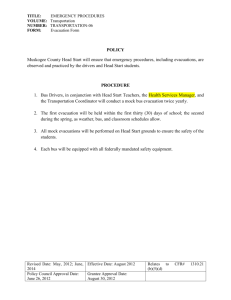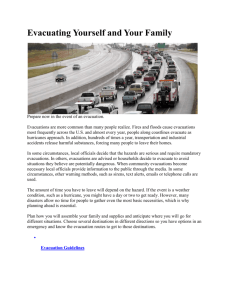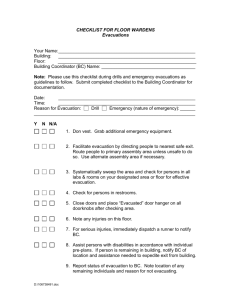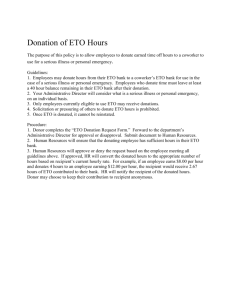April 25, 2007 Emergency Transportation Operations and Planned
advertisement
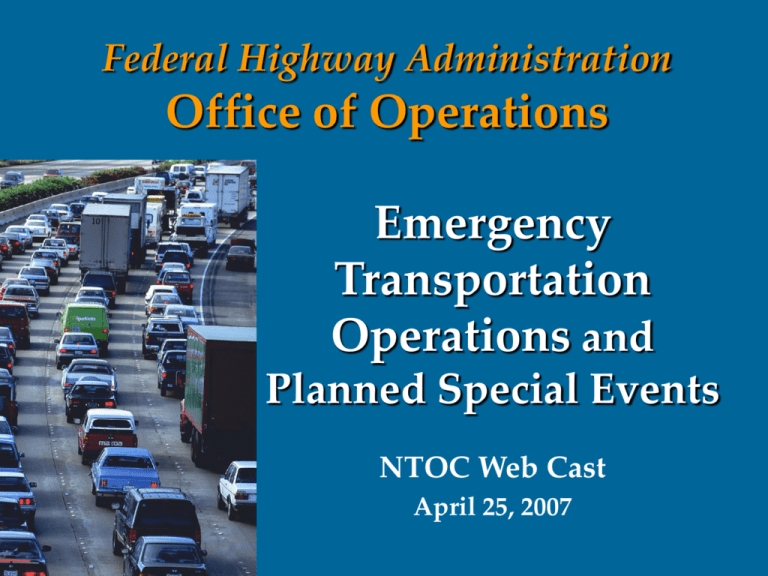
Federal Highway Administration Office of Operations Emergency Transportation Operations and Planned Special Events NTOC Web Cast April 25, 2007 How we define ETO Actions to preserve and improve transportation network efficiency and public/responder safety when a non-recurring event either interrupts or could overwhelm the transportation system. Shaded Area Demonstrates Areas Currently Covered by FHWA ETO Programs EVENT SEVERITY Traffic Incidents P R O EB VA EB NI TL I T Y Local Disasters Major/Regional Catastrophic Event Event Malevolent Act Trans Incidents PSE TIM HazMat Incidents Wildfires PSE Floods Maj Storms Malevolent Acts Evacuations ETO Continuum TRAFFIC INCIDENT MANAGEMENT Traffic Incidents: State of the Practice Successful TIM programs have: • Regional & Statewide comprise 25% Institutional Coordination of all congestion • 24/7 On-Scene TIM Operations problems • Integrated Communications & 925 million Technologies hours year However, communities continue to 1 minute of struggle with: incident duration • resource limitations leads to 4 minutes • # of institutions & differences of congestion backups • interoperability Definition: Planned Special Events Any public activity that affects the normal operation of the surface transportation system. -Does not include work zones. -Source: Managing Travel for Planned Special Events Handbook” PLANNED SPECIAL EVENTS State of the Practice Planned Special Events: New York City hosts 5,000+ Events Annually $2.5 billion annual industry in Milwaukee $1 billion+ in state tax revenues Successful PSE programs have: • • • Regional & Statewide Institutional Coordination Distinct Chronological Phases: Planning, Management & Evaluation Operations & Service Components PLANNED SPECIAL EVENTS Where Are We Now? GOOD PLAN ELEMENTS Agencies’ Participation Impact Prediction Transportation plan with contingencies Good implementation Team & interoperable communication Monitoring during the event & traffic plan modification Communities struggle with: • • • • • Travel demand Influencing travel choices Capacity & resource limitations Pedestrian & transit flow # of institutions & differences (event operator often is private sector) • • Interoperability Ad hoc teams PLANNED SPECIAL EVENTS What DOT/FHWA Is Doing: Building Partnerships Technology Transfer Transportation Professionals Emergency Managers Event Planners Chambers of Commerce ICS for Transportation Professionals & PSE Handbook Applying ITS Solutions TMCs as Transportation Ops Centers & CCTV Simulation Models Variable Message Signs Emergency Transportation Operations: The Continuum • Preparation for PSE has benefits far beyond the implementation of a well-designed transportation plan for a major event. D.C. Transportation Department officials used traffic cameras to monitor the experiment. Shown are, from left, Natalie Jones Best, Michelle Pourciau and Bill Rice. Photo Credit: By Kevin Clark -- The Washington Post EVACUATION OPERATIONS STATE OF THE PRACTICE Evacuations: 80% of New Orleans evacuated during Hurricane Katrina Successful Evacuation Programs Have: • Transportation & EM Partnership • Can Collect Real-time Traffic Data • Contraflow Planning • Plans for Communicating with Public • Cooperative relationships with shelters & those with special mobility needs • Contraflow plans, used as needed EVACUATIONS Where Are We Now? Communities Struggle with: • Lack of experience • Ability to collect real-time traffic data • Relationships—with Emergency Management, 1st responders, neighboring counties, etc. • ITS Survivability & Useful in Disaster Operations • Transportation Role in Communicating with Public • Coordination with Shelters & Groups Supporting Those with Special Mobility Needs EVACUATIONS What DOT/FHWA Is Doing: Stakeholder Coordination Technology Transfer, Training & Outreach Evacuation Plan Evaluation Criteria Primer Series Regional Seminars Research & Development Using ITS Solutions: Wireless CCTV connection to TMC & EOC Decision Support Systems GIS Weather sensors COMMON THREADS • Decision Making / Planning • Information / Data Collection / Coordination • Communications • Traffic Control CHALLENGES •Integration of transportation ops into emergency management operations •Compatibility •Scalability •Partnerships EVENT SEVERITY Traffic Incidents P R O EB VA EB NI TL I T Y Local Disasters Major/Regional Catastrophic Event Event Transportation Trans Incidents HazMat Incidents Wildfires Emergency managers 1st responders TIM TIM Shelter managers Health & medical Floods Maj Storms Malevolent Acts Malevolent Act Transportation Emergency Responders At Federal, State Regional & Evacuation Planning Local levels PARTNERSHIPS FUTURE ITS WORK & APPLICATIONS FOR ETO •Vehicle Infrastructure Integration •Next Generation 911 •Integrated Corridor Management •Road Weather Management Tools ETO Program Key Contacts • Kimberly Vasconez FHWA Emergency Transportation Operations Team Leader, (202) 366-1559 • Laurel Radow FHWA Evacuation & Planned Special Events Program Manager (202) 3662855 • FHWA ETO website http://www.ops.fhwa.dot.gov/opssecurity • Recommended Multi-functional Site on ETO & Evacuation Management http://www.llis.gov
